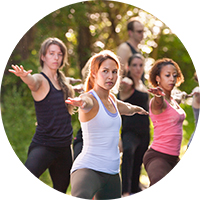Teaching a Trauma-Informed Yoga Class
By: Marissa Angeletti, E-RYT 200 and Yoga Alliance Foundation scholarship recipient
April 21, 2016

Regardless of the depth of your students’ trauma and its impact on their lives, you have a unique opportunity as a trauma-informed yoga teacher to provide a safe and reparative experience for those in your class. As a movement-based trauma specialist and educator, I have worked with a variety of clients and seen the subtle and nuanced approach of trauma-informed teaching transform students’ lives. Here are a few basic suggestions to keep your class safe and accessible for all, including those working through trauma, anxiety or depression.
Create a Safe Space
Introduce yourself, state the type of class you’re going to teach and give a lead-in statement of what the class will focus on before starting. Describe the “arc” or the outline of the class so that the time is contained and students know what is coming up. If anything is going on in the surrounding environment (e.g. noise outside the studio, a student who may have to leave early, or if your class tends to have late-comers), name it to normalize the space. Minimize the chance of activating your students’ sympathetic nervous system, or the “fight-or-flight” response, so they can reap the benefits of their shared yoga practice.
Bring the Group Together
As I center my students and guide them to focus on their breath, I take the opportunity to create a cohesive group space for our experience together. There are many ways to do this, but breath is one of the most powerful. For example, you could say: “Let’s bring the breath together 3 times now. Everyone: deep inhale together, exhale completely.” I have been amazed by how much this impacts the collective experience and energy in the room. It creates group cohesion and safety. This directive also allows the student to decide what a deep inhale means for them, and what exhaling completely means.
Allow for Choices
Building upon the previous point, offer choices throughout class. This not only includes variations of asana to modify or intensify, but also statements such as “Guide the eyes closed, or if that doesn’t feel okay today, gently soften the eyes or gaze.” When I incorporate essential oils into my class, I say, “If you would like some lavender oil, please place one hand on your belly, and leave the other hand palm facing up.” In trauma, choice has been revoked, so it is fundamentally important to restore it whenever possible. Choice is empowering. Let the student decide how and what their experience will be.
Provide Context
As you teach, provide explanations about why you’re doing what you’re doing – and know the reasons for yourself. Try to avoid blanket statements that assume everyone is having the same experience, such as, “sadness and anger live in the hips.” Instead, try explaining what you mean and offer context. For example, you could say: “We tend to hold various emotions in the hips because of the dense nerve bundles located here that correspond to the brain. It’s common for a variety of emotion or experience to come up as we work this pose. Explore what this means and feels like to you.” Invite choice even here, by allowing the student to discover what working a hip opener means for them, rather assigning a particular meaning to a hip opener.
Intention vs. Impact
If your intention is to guide a student more deeply into asana, ask yourself how that can be done. Physical adjustments are one way, but when the relationship between teacher and student is new, or when the student is working through trauma, they may be counterproductive. All trauma lives in the body, therefore, touch can be triggering and re-traumatizing. If you decide to utilize physical adjustments, make them consensual – ask students at the beginning of practice to signal you if touch is something they do not want, or ask quietly before offering physical touch or adjustment. In my teaching, I actually tend not to physically adjust more often than not, because even if the choice is offered, a student may not be comfortable enough to say no. Instead, I utilize verbal adjustments such as “bend your knee to meet my hand,” as I place my hand in front of their knee, for example.
 Marissa Angeletti, M.A. and E-RYT 200, is one of the winners of the Yoga Alliance Foundation’s 2015 scholarships. Marissa is a yoga teacher and movement-based trauma specialist whose personal practice and experiences inform and inspire her appreciation for the body/mind connection. We thank Marissa for her contributions to the yoga community and for sharing her knowledge with us!
Marissa Angeletti, M.A. and E-RYT 200, is one of the winners of the Yoga Alliance Foundation’s 2015 scholarships. Marissa is a yoga teacher and movement-based trauma specialist whose personal practice and experiences inform and inspire her appreciation for the body/mind connection. We thank Marissa for her contributions to the yoga community and for sharing her knowledge with us!